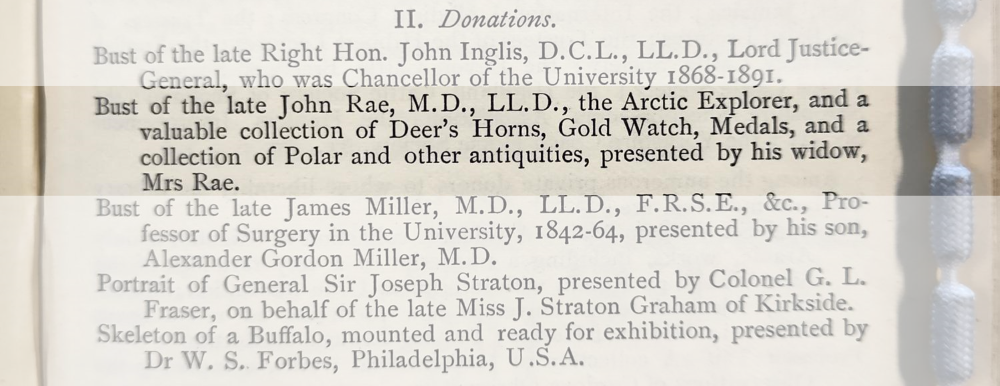As part of ongoing work on the University’s historic loans, Collections Registrar, Morven Rodger, investigates the history and provenance of the University’s John Rae collection.
In July 1926, the University Court agreed to lend the “John Rae Collection of Arctic and Other Relics” to the Royal Museum of Scotland. Almost a century later, The Royal Museum is now the National Museum of Scotland, and John Rae’s items remain on loan, but how and why did the University come to have these items in the first place?
John Rae was born in Orkney in 1813 and came to Edinburgh in 1829 to study medicine at the University of Edinburgh. Following his studies he entered the employment of the Hudson Bay Company, and would go on to explore the Arctic coast using tools and techniques he learned from Inuit and First Nations people. Through these relationships, he learned the fate of the Franklin Expedition and purchased items recovered from Franklin’s crew to corroborate his story.
Having gathered these items in the course of his employment with the Hudson Bay Company, the Company laid claim to the ‘greater portion’ of the Franklin relics. These were presented to Greenwich Hospital by the Lords Commissioners of the Admiralty on 2nd December 1854, and later entered the collections of the Royal Museum Greenwich.
With the Company’s permission, Rae retained a few of these relics and accumulated many more fascinating items over the course of his travels. Among these are gifts, such as a book of sacred poetry, given to him by Franklin’s daughter Eleanor, in which he marked the pages of his favorite verse, and items he made himself, in emulation of local craftspeople, like a model salmon spear crafted by Rae in the style of the Mi’kmaq people of New Brunswick.

Kate and John Rae, c.1860, courtesy of Orkney Library and Archive (Ref. L218-3)
John Rae died in London in 1893, and was buried at St Magnus Cathedral, in Kirkwall, Orkney, but our story does not end there. Most of Rae’s property was left to his wife, Catherine Jane Alicia Thompson (b.1838, Dublin – d.1919, Kent), also known as Kate.
Listed in John Rae’s will, on the website of the National Records of Scotland, are his medals and Franklin relics, which he bequeaths to his wife on “the understanding that she bequeath the same to any of my nephews or nieces or their descendants whom she may consider most worthy”. Kate Rae also inherits her husband’s “stone implements […] and other curiosities”, suggesting that “after her death or if she does not care to keep them that these be given to the Museum of the Edinburgh University Scotland where I studied medicine and to be placed there if possible in one group.”
It seems Mrs Rae did not care to keep them, and perhaps finding none of her late husband’s relatives ‘worthy’ of the medals and Franklin relics, she generously gifted these to the University in 1893, along with a bust of his likeness and “a valuable collection of Deer’s Horns [sic]”.
Thirty-three years after the gift, at the time of the initial loan to the Royal Museum of Scotland, the collection was recorded by the Museum in a typewritten catalogue, pictured above (SD 3907). The antlers are absent from the catalogue, and the bust is noted as having remained at the University, where it was later accessioned into the University Art Collection.
The bust can be seen today in the corridors of the University’s Anatomical Museum. As for the rest of this collection, there is still work to be done if we are to make this findable, accessible and relevant to today’s University community. There is no natural home for a collection of this scope in our libraries or archive, or the established art and museum collections, and there are materials like walrus ivory, grizzly bear claws, and hides, which we are not accustomed to managing. For the time being, they are in safe hands with National Museums Scotland, where they can be seen and enjoyed, free of charge, by visiting members of the public.
As of October 2024, more than 50 items from the John Rae collection are on display at the National Museum of Scotland. The rest of the collection can be accessed by appointment at the National Museums Collections Centre.





